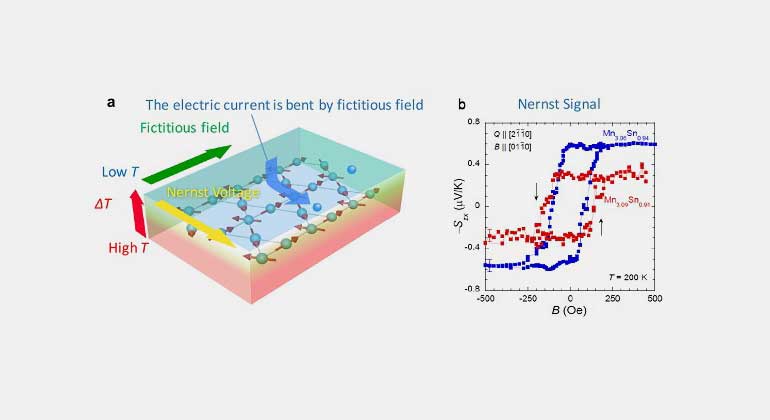New technology using magnet to generate electricity from heat
Large anomalous Nernst effect discovered in antiferromagnet
University of Tokyo researchers and their collaborators at RIKEN observed an unexpectedly large thermomagnetic effect, called the anomalous Nernst effect, in an antiferromagnet, a type of magnetic material, for the first time. The study’s findings, demonstrating a new method for regulating thermoelectric performance, provides a novel and potentially useful guideline for the future exploration of thermoelectric materials.
The anomalous Nernst effect is the voltage generated spontaneously when a magnetic conductor is exposed to a temperature gradient, even in the absence of a magnetic field. Since its discovery about a century ago, this effect was long assumed as being proportional to the magnetization of the material, thus appearing only in ferromagnets, which have strong magnetization, and was not expected to occur in materials with zero magnetization like antiferromagnets. Strikingly, the joint research team found a large anomalous Nernst effect in manganese-tin alloy Mn3Sn, an antiferromagnetic metal.
The widely known anomalous Hall effect is the spontaneous voltage generated across an electric current commonly found in ferromagnets. According to the modern theory of electron transport, the anomalous Nernst effect and anomalous Hall effect are linked by a quantity known as the Berry phase present in the quantum mechanical waves of electrons; the fictitious magnetic field originating in the Berry phase and produced by the spin structure can deflect the motion of electrons in a fashion similar to a real magnetic field. Based on this theory, a certain class of antiferromagnets with a noncollinear (nonlinear) arrangement of magnetic moments created by regulating the spin structure would show large anomalous-Hall conductivity. In a previous study, the University of Tokyo group was the first to experimentally verify this effect—equal to or surpassing that found in ferromagnetic material—in the noncollinear antiferromagnetic metal Mn3Sn.
The University of Tokyo research group led by Professor Satoru Nakatsuji at the university’s Institute for Solid State Physics has studied the anomalous Nernst effect in its newly synthesized large single crystals of Mn3Sn. The group was surprised when it found that the anomalous Nernst effect in Mn3Sn is more than 100 times larger than the estimate derived from its magnetization, on par with the highest value measured for a ferromagnetic metal. Moreover, experiments on two crystals with different compositions were quantitatively consistent with calculations performed by the team at RIKEN, suggesting the presence of particles called Weyl fermions as the source of the large fictitious magnetic field. If the presence of Weyl fermions in Mn3Sn is verified through other experiments in the future, it would make the alloy the long-sought magnetic Weyl metal.
In terms of applications, the anomalous Nernst effect has garnered interest despite its significantly smaller magnitude compared to the much more well-known and utilized thermoelectric effect in nonmagnetic semiconductors. The advantage of a thermoelectric generator based on the Nernst effect lies in the simpler design made possible by the effect; furthermore, the metal’s malleability allows more efficient coverage of the heat source.
“Although the Nernst effect we found in antiferromagnets is relatively large compared to those found in ferromagnets, its magnitude is still low for practical purposes,” says Nakatsuji. He continues, “However, this study shows a large potential for the thermoelectric application of magnets. We believe our work will lead to the discovery of novel, thermoelectric materials in the future.”
This study was supported by the Strategic Basic Research Programs (CREST) of the Japan Science and Technology Agency (JST) as a project covering “From understanding of topological electronic structure toward development of basic technology for energy harvesting” in the research area “Scientific Innovation for Energy Harvesting Technology.”
Paper
Muhammad Ikhlas, Takahiro Tomita, Takashi Koretsune, Michi-To Suzuki, Daisuke Nishio-Hamane, Ryotaro Arita, Yoshichika Otani, Satoru Nakatsuji , “Large anomalous Nernst effect at room temperature in a chiral antiferromagnet“, Nature Physics Online Edition: 2017/07/24 (Japan time), doi: 10.1038/nphys4181. Article link (Publication)








